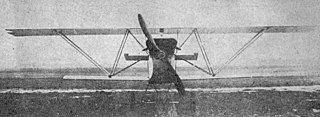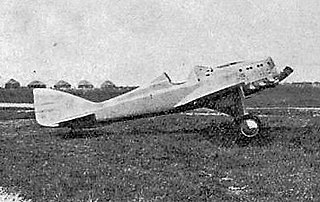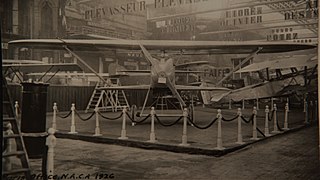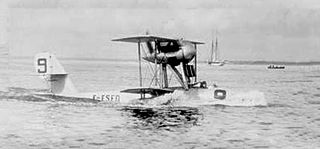
The Bergamaschi C-1 and C-2 were Italian single-engined light trainers built by Cantieri Aeronautici Bergamaschi for the Bergamo flying school.

The Couzinet 70 was a 1930s French three-engined commercial monoplane built by Société des Avions René Couzinet founded by René Couzinet.

The Potez 540 was a French multi-role aircraft of the 1930s. Designed and built by Potez, it served with the French Air Force as a reconnaissance bomber, also serving with the Spanish Republican Air Force during the Spanish Civil War. Although obsolete as a bomber, it remained in service in support roles and in France's overseas colonies at the start of World War II.

The Loire 102 was a 1930s French flying boat designed as a mail plane by Loire Aviation.

The Morane-Saulnier Vanneau is a two-seat basic trainer built in France by Morane-Saulnier and ordered by the French Air Force.

The Dewoitine D.513 was a 1930s prototype French monoplane fighter designed and built by Dewoitine.
The Avia 156 was a 1930s Czechoslovakian six-passenger commercial transport airliner for both mail and passengers, designed by Robert Nebesář and built by Avia. The type performed well but only one was built.

The Bernard SIMB AB 14 was a 1920s French single-seat sesquiplane fighter aircraft designed and built by the Société Industrielle des Métaux et du Bois (SIMB). With a reluctance of the French authorities to purchase monoplanes the Bernard 14 was designed as a sesquiplane with Y-form struts bracing the wings on each side. It was powered by a Hispano-Suiza 12Hb inline piston engine and had a fixed tailskid landing gear. While on a test flight on 22 February 1926 the aircraft suffered a catastrophic structural failure of the upper wing and the only Bernard 14 was destroyed.

The Bernard 20 was a 1920s French single-seat monoplane fighter aircraft designed and built by the Société des Avions Bernard. Originally displayed as a mock-up at the 1928 Paris Air Show it was a low-wing monoplane based on the Bernard V2 racer. The prototype powered by a 400 hp (298 kW) Hispano-Suiza 12Jb inline piston engine first flew in July 1929 from Orly. With its racing inheritance, in 1930 the aircraft flew at a speed of 280 km/h (174 mph). With the lack of interest by the French authorities for monoplanes the project was abandoned after 18 months of test flying.

The CAMS 31 was a 1920s French single-seat fighter biplane flying-boat designed and built by Chantiers Aéro-Maritimes de la Seine (CAMS).

The Bernard 15 C1 or Bernard SIMB AB 15 was a 1920s French single-seat sesquiplane fighter aircraft designed and built by the Société Industrielle des Métaux et du Bois (SIMB). With the structural failure of the earlier Bernard 14 the Bernard 15 was an improved variant with a greater span upper wing. It was powered by a Hispano-Suiza 12Hb inline piston engine and had a fixed tailskid landing gear. The performance was not an improvement on the Bernard SIMB AB 14 and only the prototype was built.
The Breguet 890 Mercure was a late 1940s French cargo and passenger transport aircraft designed by Breguet Aviation. Three variants were produced including a military variant called the Mars but none entered production.
The Breguet 482 was a French four-engined bomber aircraft of the 1940s. It was designed prior to the outbreak of the Second World War, two prototypes were nearing completion when Germany invaded France in 1940, with one being flown after the end of the war as an experimental platform.

The Bernard 82 was a French single-engined long-range monoplane bomber designed and built by Société des Avions Bernard. Only two prototypes were built and the type did not enter production.
The Borel-Odier Bo-T was a French twin-engined float biplane designed by Borel but built by Antoine Odier for the French Navy.
The Blériot 195 was a French monoplane mail-carrier designed and built by Blériot Aéronautique, the one aircraft built was modified a number of times but failed to enter production.

The CAMS 38 was a French single-seat racing flying-boat designed by Rafaele Conflenti and built by Chantiers Aéro-Maritimes de la Seine (CAMS) for the 1923 Schneider Trophy race. The CAMS 38 was withdrawn from the race during the second lap.

The Bernard H.V.120 was a 1930s French racing seaplane designed and built by Bernard to compete in the Schneider Trophy race. Delays caused by engine problems and the crash of the second aircraft delayed entry and the aircraft did not race in the competition.

The CAMS 36 was a 1920s French flying boat designed and built by Chantiers Aéro-Maritimes de la Seine. It was originally conceived as a single-seat fighter but evolved as a racer to compete in the 1922 Schneider Trophy race. Lack of funds in 1922 and an accident in 1923 meant the two aircraft built failed to participate in a Schneider race.

The Buscaylet-de Monge 5/2 was a 1920s French single-seat, parasol-wing fighter prototype designed by Louis de Monge for the Buscaylet et Cie company.



















